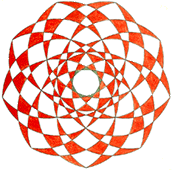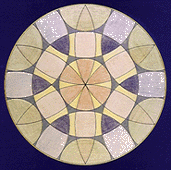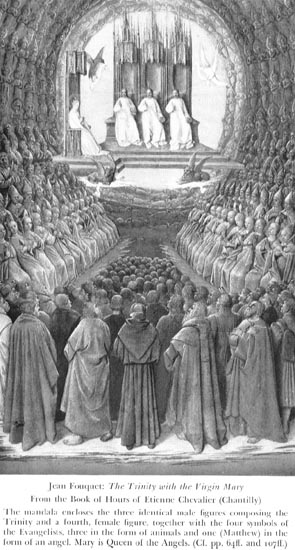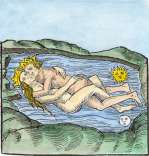|
Praxis für Alternative
Psychosomatik und Traumdeutung, Dr. Remo F. Roth, CH-8001
Zürich
|

|
Remo F. Roth
Dr. oec. publ., Ph.D.
dipl. analyt. Psychologe (M.-L. v.
Franz)
|

|
© 200 2-2004
by Pro Litteris, Zurich, Switzerland and Remo F. Roth, Horgen-Zurich. All Rights
Reserved. dr.remo.roth@psychovision.ch.
Republication and redissemination of the contents of this screen or any part of
this website are expressly prohibited without prior psychovision.ch written
consent.
With many thanks to Gregory Sova, Ph.D.
(LA, CA) for
translation assistance
Book Project:
THE RETURN OF THE WORLD SOUL
Wolfgang Pauli, Carl Jung and the Challenge
of the Unified Psychophysical Reality
© copyright 2002-2004 by
Pro Litteris, Zürich. All rights reserved
This book is
intended for private use only, and is copyrighted under existing Internet
copyright laws and regulations.
back
to Chapter 3, part 1
3. Carl Jung's
quaternity, Neoplatonic philosophy and the "potential being" of
Aristotle
(part
2)
Contents:
part1:
3.1
Wolfgang Pauli's criticism at the newly founded
institute
3.2 Carl Jung's "quaternities, projected
into heaven"
part
2:
3.3
Being, nonbeing and potential being
3.3.1
The Assumptio Mariae and the "disinfected" matter in the
heaven
3.3.2 The
coniunctio as the constellated archetype behind the
Assumption
3.3.3 The
coniunctio and Carl Jung's individuation
process
3.3.4 "To
be or not to be" and the Platonic privatio
boni
part
3
(will follow):
3.3.5
The potential being of Aristotle
3.3.6
Complementarity: Particle and wave as potential
being
3.3.7
Pauli's conflict with Jung: The collective unconscious as
potential being
part
4:
3.3.8 "Quaternities projected into heaven" and
the unsolved psychophysical problem
3.3.9 The
spirit of matter, the acausal aspect of the divine world soul
and potential being
3. Carl Jung's quaternity,
Neoplatonic philosophy and the "potential being" of
Aristotle
(part 2)
3.3 Being, nonbeing and potential
being
3.3.1 The Assumptio
Mariae and the "disinfected" matter in the heaven
Pauli formulated the expression of the
"quaternities projected into heaven" in the context of his criticism
of Carl Jung's book Answer to Job, published in 1952. He read
the book in the fall of that year and then, in February 1953, wrote
the letter to Jung which he titled :"'To be' or 'not to be', this is
the question", the famous quotation out of Shakespeare's Hamlet. The
letter contains a lengthy treatise that is a criticism of Jung's
Answer to Job. In a very sarcastic way Pauli titles it
Betrachtungen eines Ungläubigen über Psychologie,
Religion und Ihre Antwort auf Hiob (Reflections of an Unbeliever
on Psychology, Religion, and your Answer to Job).
 Carl
Jung's book Answer to Job consists of two main parts. In the
first part he deals with Job's fate, in the second with the dogma of
the Assumptio Mariae, proclaimed by the Pope Pius XII in the
year 1950. The criticism of Pauli, the "Unbeliever", is focused on
this second part of Jung's book. Pauli states that this dogma is a
"countermeasure against the devil" . Then he continues: Carl
Jung's book Answer to Job consists of two main parts. In the
first part he deals with Job's fate, in the second with the dogma of
the Assumptio Mariae, proclaimed by the Pope Pius XII in the
year 1950. The criticism of Pauli, the "Unbeliever", is focused on
this second part of Jung's book. Pauli states that this dogma is a
"countermeasure against the devil" . Then he continues:
"Of course, in the 20th
century I cannot really understand what the pope means when he
says 'Heaven' ... It does acquire some meaning for me if I
identify 'Heaven' here with the 'place beyond Heaven', the
non-physical space in which, in accordance with Platonic
philosophy, 'Ideas' are to be found. This is probably not all that
arbitrary inasmuch as historically, Christianity has taken over
many words and expressions from Plato and the Platonists."
He goes on and states that this "maneuver" of
the pope is a "concession to matter",
"which, since the days of
Neoplatonism, has counted only as the privatio [the absence;
RFR] of ideas and as evil, or as the Devil in Christian
terms".
We will come back to the so-called
privatio boni, a Platonic and Neoplatonic concept, the fathers
of the church have taken over.
Pauli then harbours doubts "as to whether
this concession is enough, since in the new dogma it is actually
strongly 'disinfected' matter." Of course Pauli speaks here of the
fact that the Catholic Holy Virgin Mary is only defined above the
diaphragm, because in the Platonic, Neoplatonic and Christian
philosophy matter, instincts and the female principle are diabolised.
The dogma of the Immaculate Conception states that she is without any
sin; her dark side is not accepted. Therefore, when she is taken into
heaven, this obscure side is neglected.
If Mary as a female "goddess" is - in a depth
psychological language - seen as a symbol of matter, there exists
another problem. Therefore Pauli states that:
"matter
will be taken into the world of ideas, not in its inorganic form but only in
connection with the soul, the 'metaphysical' representation of
woman."
These statements show us, that for Pauli,
the dogma of the
Assumption functions not only as
a countermeasure against the devil, but also as a
Platonic or Neoplatonic idea. In
this dogma, matter
is evil, therefore, only when matter is "disinfected", can it be
affiliated in the Empyreum, the "place beyond Heaven" as conceived by
Plato. We will see in the fourth
chapter that this idea is the central content of Neoplatonic alchemy,
in contrast to the Hermetic alchemy of Robert Fludd, of whom Pauli
was fascinated to such a high degree.
This Neoplatonic tendency of the dogma is the
main reason, why Pauli does not like it at all. In the letter
[1646] to Fierz I will quote below (see sec. 3.3.9), he even
"protests against the Assumption of the Queen".
3.3.2 The coniunctio as
the constellated archetype behind the Assumption
Nevertheless the Nobel laureate is convinced
that the deeper background of the Assumption is the fact
"that we are all - as
children of the 20th century - affected unconsciously by the same
archetypal occurrences",
which are present as the idea of a new
hierosgamos (coniunctio or chymic wedding; s. chap. 4)
in Carl Jung's depth psychology, as a compensation "for the
one-sidedness that ensued after the pioneering scientific
achievements of the 17th century" in quantum physics, and in "the
pope, who, by way of sanctioning an ancient popular belief, declares
a new dogma.".
Therefore, we can conclude that Pauli refuses
the dogma but is convinced that behind it there is a very important
new archetypal idea, the coniunctio, not correctly interpreted
by the Pope.
He continues:
"But as a symbol of the
monistic union of matter and soul, this Assumptio has an even
deeper meaning for me. Any deeper form of reality - i.e., every
'thing as such' - is symbol for me anyway, and only the
'manifestation' is concrete."
Then he goes on:
"It is true that in the
empirical world of phenomena there must always be the difference
between 'physical' and 'psychic', and it was the mistake of
alchemists to apply a monist (neutral) language to concrete
chemical processes. But now that matter has also become an
abstract invisible reality for the modern physicist, the prospects
for a psychophysical monism have become much more
favourable."
These statements contain the essence of
Pauli's view of the archetypal background of the new dogma: Today, we
are all influenced by an archetypal occurrence, which shows us that
we need a correction to the one-sided development of science since
the 17th century. This constellated archetype is the
hierosgamos, the sexual unity of a god with a goddess, that
alchemy described as the coniunctio oppositorum, and
which we can - in modern terms - paraphrase as a union of matter and
soul at the background of a monistic psychophysical reality, which is
itself invisible. After Pauli, alchemy - but, as we will see, only
the Hermetic part of it - has already had a neutral language for
describing such a coniunctio, but did not succeed because it
applied it to the concrete outer world.
3.3.3 The coniunctio
and Carl Jung's individuation process
In the continuation of his letter, Pauli
makes reference to a parallel idea concerning this new dogma, which
Jung states in § 739 of Answer to Job. Jung writes
there:
"Ever since John the
apocalyptist experienced for the first time (perhaps
unconsciously) that conflict into which Christianity inevitable
leads, mankind has groaned under this burden: God wanted to become
man, and still wants to. That is probably why John experienced in
his vision a second birth of a son from the mother Sophia, a
divine birth which was characterized by a coniunctio oppositorum
and which anticipated the filius sapientiae, the essence of the
individuation process. [Jung, CW 11, § 739;
emphasis mine]
In the individuation process Jung requires
the conscious realization of the Self, the center of the collective
unconscious, in ones individual life because for him the Self is the
inner image of God. The individuation process is also a conscious
observation of God's incarnation in every individual. But as he
describes in Answer to Job, (See also, CW 11, § 713), it
cannot be the incarnation of Jesus Christ, the salvator
microcosmi, but of a new salvator, the salvator macrocosmi [CW 13, §383-86],
whom the alchemists had anticipated as
the above mentioned filius sapientiae, the divine child of the
coniunctio oppositorum, the sexual relationship of their god
and the goddess.
Therefore, it will be a very important task
for us, to define the structure of this new image of God. We will
see, that for Jung it was the quaternity which will replace the
Trinity of the Catholic Church, but in the unconscious of Wolfgang
Pauli, another symbol was constellated: a double trinity, known as
the Seal of
Solomon or the Star of
David.
In relation to the individuation process, the
very interesting aspect is that this alternative image of God is not
originally Jewish - as most people believe - , but belongs to the
mysticism of all five world's religions, and is always associated
with the human heart. [see Some
Thoughts..., section 1.1, esp. footnote 1]
As Jung describes in § 738 of Answer
to Job,  this
coniunctio oppositorum is the "real subject of Hermetic philosophy" [emphasis mine].
The
result of this sexual union between the male and the female god is
the filius sapientiae (the child; see below), which Jung now [§ 738] compares
with the goal of the opus, the
lapis (the stone). Then he parallels the lapis and the
filius with the son of the sun-woman of the Revelation, and even
states that this final product is some sort of homunculus. We
will see in the fourth chapter, that Robert Fludd, Wolfgang Pauli's "shadow brother",
called it the infans solaris. For Gerardus
Dorneus it was the red tincture, which the alchemist had to extract
out of the lapis. this
coniunctio oppositorum is the "real subject of Hermetic philosophy" [emphasis mine].
The
result of this sexual union between the male and the female god is
the filius sapientiae (the child; see below), which Jung now [§ 738] compares
with the goal of the opus, the
lapis (the stone). Then he parallels the lapis and the
filius with the son of the sun-woman of the Revelation, and even
states that this final product is some sort of homunculus. We
will see in the fourth chapter, that Robert Fludd, Wolfgang Pauli's "shadow brother",
called it the infans solaris. For Gerardus
Dorneus it was the red tincture, which the alchemist had to extract
out of the lapis.
But let us return to Pauli's letter. After
quoting this passage of Jung's Answer to Job he expresses his
agreement with Jung's idea that the Assumption belongs to "a definite
stage of the individuation process" (that we will discuss below).
When we include the above explanations of Jung, we see that Pauli
accepts the hypothesis that the
Assumptio Mariae and the coniunctio of Hermetic alchemy are
prefigurations of the constellated individuation process manifesting
in our time.
In a modern language this archetypal
occurrence must have to do with a monistic
psychophysical reality, which is
realized, when the chymic wedding of a male and a female god has
taken place and as a result of this coniunctio a child has
been born, which is, after Jung, the homunculus.
Thus, we must find out, how we can describe
this 21st century's archetypal occurrence in terms of a modern "neutral language" beyond
quantum physics and depth psychology. Hermetic alchemy already had a vision of
this process - but expressed
in an archaic language. Thus, in the following chapters we will go back to
Robert Fludd and Gerardus Dorneus
for the purpose of finding out how we could formulate this challenge
in the terms of 21st century's scientific language.
3.3.4 "To be or not to be" and
the Platonic privatio boni
To do this, let us first return
to Pauli's letter. Toward its end he comes back to the above
mentioned motto "To
be or not to be" (see 3.3.1). With it he characterizes the
confrontation between "being" and "nonbeing", begun in ancient
philosophy. First he tells us that "nonbeing" "did not simply mean
not being present" but is "that which cannot be thought about",
"which cannot be reduced to notions and concepts". "Being", by
contrast, is that which can be grasped by the reasoning process
associated with the thinking function.
In a section that is absent in the German
original [Meier, 1992] and in the English translation
[Meier, 2001], but is included in the copy of the letter in
Pauli's Wissenschaftlicher Briefwechsel, he continues, that
for us today "nonbeing" means "irrational" and "obscure". Moreover,
since Socrates and Plato Good is defined as the rational and Evil is
only the absence of Good, a privatio boni.
This Platonic definition, which is also the
official doctrine of the Catholic Church, was attacked by Wolfgang
Pauli as well as by Carl Jung, for example in a note of § 600 in Answer to Job. Pauli quotes parts of this note; therefore we
will include it in our argumentation:
"The naive assumption that
the creator of the world is a conscious being must be regarded as
a disastrous prejudice which later gave rise to the most
incredible dislocation of logic. For example, the nonsensical
doctrine of the privatio boni would never have been
necessary had one not had to assume in advance that it is
impossible for the consciousness of a good God to produce evil
deeds. Divine unconsciousness and lack of reflection, on the other
hand, enable us to form a conception of God which puts his actions
beyond moral judgement and allows no conflict to arise between
goodness and beastliness." [Jung, CW 11, § 600, n.
13]
When one reads the letter, one feels that
Pauli is very happy about Jung's remark on the privatio boni as a "nonsensical doctrine".
Of course it is Jung's approach to an
image of God, which is a coniunctio oppositorum he
likes so much. We will see that this symmetry of a renewed image of
God is very important for the Nobel laureate.
Pauli continues his letter by comparing the
Platonic Ideas with the phenomenon of matter. The logical conclusion
of the above statements is, that matter is only the absence of these
Ideas. We can generalize this Platonic prejudice and say that matter
is only the absence of the spirit. As Jung has seen [CW 12,
§ 405-13; The spirit in matter] it was exactly
alchemy that compensated this devaluation of matter by the postulate
of the "spirit in matter", which it also called the Spirit Mercurius
[CW 13, § 239-303].
In the letter, Pauli goes on and shows a
further assumption of the Platonic philosophy about matter: Because
Ideas are "being", they are also eternally unchangeable. Therefore,
"the process of becoming and the changeable, hence also matter,
appeared in a certain form of psychology as nonbeing".
We can summarize these Platonic statements as
follows:
Spirit (the Platonic Ideas) is the
Good, the eternally unchangeable, is rational and therefore "being", but
Matter is the Evil, the changeable, the
irrational and therefore "nonbeing", and
Matter is a privatio of Spirit, as
the Evil is a privatio of Good
This Platonic philosophy is also behind the
determinism of classical natural science and is the deeper reason,
why it is the intention of every scientist, to find "eternal" causal
natural laws behind the changeable, behind motion, which is itself a
property of matter.
Chapter
3, part 3
See also further articles about
Wolfgang Pauli in
http://www.psychovision.ch/rfr/roth_e.htm
back

14.2.2003
|